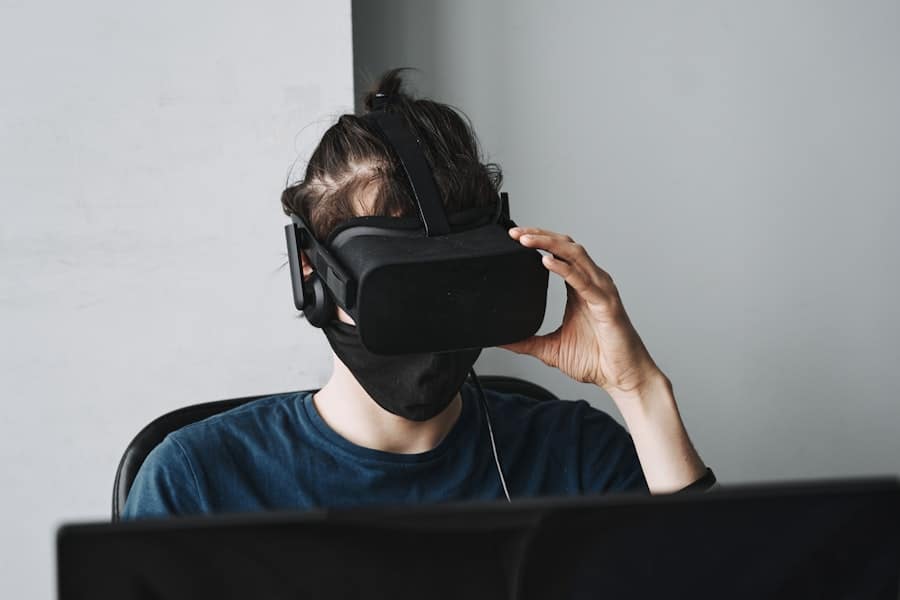The concept of a mind-controlled metaverse is rapidly evolving, merging the realms of neuroscience, technology, and virtual reality into a singular, transformative experience. As we stand on the brink of a new digital frontier, the idea of interacting with virtual environments through thought alone is no longer confined to the pages of science fiction. Instead, it is becoming a tangible reality, driven by advancements in brain-machine interfaces (BMIs) and neurotechnology.
This innovative approach promises to revolutionize how we engage with digital spaces, allowing users to navigate, create, and communicate in ways that were previously unimaginable. The mind-controlled metaverse represents a paradigm shift in human-computer interaction, where the boundaries between the physical and digital worlds blur, offering unprecedented opportunities for creativity, collaboration, and connection. As we delve deeper into this fascinating intersection of technology and human cognition, it becomes clear that the implications of a mind-controlled metaverse extend far beyond mere entertainment.
This new frontier has the potential to reshape industries, enhance education, and even redefine social interactions. By harnessing the power of our thoughts, we can create immersive experiences that respond intuitively to our intentions, fostering a sense of presence and agency that traditional input methods cannot replicate. The journey toward realizing this vision is fraught with challenges and ethical considerations, yet the promise of a mind-controlled metaverse invites us to explore the depths of human potential and the future of digital existence.
Key Takeaways
- Mind-controlled metaverse is a virtual reality environment that can be controlled using brain signals.
- Brain-machine interface has the potential to revolutionize virtual reality by allowing users to interact with the environment using their thoughts.
- Thought-controlled virtual worlds enable users to navigate and interact with the virtual environment using only their mind.
- Digital telepathy in VR can have implications for communication and social interaction within the virtual world.
- Advancements in VR brain technology are paving the way for more immersive and intuitive virtual reality experiences.
The Potential of Brain-Machine Interface in Virtual Reality
Brain-machine interfaces (BMIs) serve as the cornerstone of the mind-controlled metaverse, enabling direct communication between the human brain and external devices. These sophisticated systems translate neural activity into actionable commands, allowing users to interact with virtual environments using their thoughts. The potential applications of BMIs in virtual reality are vast and varied, ranging from gaming and entertainment to rehabilitation and education.
For instance, individuals with mobility impairments could navigate virtual worlds seamlessly, experiencing a sense of freedom and agency that may be limited in their physical lives. This capability not only enhances accessibility but also opens new avenues for social interaction and community building within virtual spaces. Moreover, the integration of BMIs into virtual reality can lead to more immersive and personalized experiences.
By analyzing brain activity in real-time, these interfaces can adapt the virtual environment based on the user’s emotional state or cognitive load. Imagine a virtual classroom where the curriculum adjusts dynamically to match students’ engagement levels or a gaming experience that evolves according to players’ emotional responses. Such advancements could significantly enhance learning outcomes and entertainment value, creating environments that are not only engaging but also responsive to individual needs.
As researchers continue to refine BMI technology, the possibilities for its application in virtual reality are limited only by our imagination.
Exploring the Concept of Thought-Controlled Virtual Worlds

The notion of thought-controlled virtual worlds invites us to reconsider how we interact with digital environments. In these immersive spaces, users can manipulate their surroundings through mental commands, effectively transforming their thoughts into actions. This concept challenges traditional input methods such as controllers or keyboards, offering a more intuitive way to engage with technology.
By tapping into the brain’s natural processes, thought-controlled virtual worlds could facilitate a deeper connection between users and their digital experiences. This level of interaction not only enhances user engagement but also fosters creativity, as individuals can express themselves in ways that transcend physical limitations. Furthermore, thought-controlled virtual worlds have profound implications for storytelling and content creation.
Imagine a narrative-driven game where players shape the storyline through their thoughts and emotions, creating a unique experience tailored to their preferences. This level of interactivity could redefine how we consume media, shifting from passive observation to active participation. Additionally, artists and creators could leverage thought-controlled environments to explore new forms of expression, blurring the lines between creator and audience.
As we explore these possibilities, it becomes evident that thought-controlled virtual worlds hold the potential to revolutionize not only how we interact with technology but also how we understand ourselves within it.
The Implications of Digital Telepathy in VR
Digital telepathy represents a groundbreaking advancement in communication within virtual reality environments. By enabling users to share thoughts and emotions directly with one another, this technology could foster deeper connections and understanding among individuals in digital spaces. Imagine a scenario where friends separated by distance can experience each other’s feelings in real-time while engaging in a shared virtual experience.
This level of empathy could transform social interactions, allowing for more meaningful connections that transcend geographical barriers. Digital telepathy could also enhance collaborative efforts in professional settings, enabling teams to brainstorm ideas and solve problems more effectively by tapping into each other’s cognitive processes. However, the implications of digital telepathy extend beyond mere social interaction; they raise significant questions about privacy and consent.
The ability to share thoughts directly could lead to unintended consequences if not managed carefully. Users may find themselves vulnerable to unwanted intrusions into their mental space or may struggle with the ethical implications of sharing their innermost thoughts with others. As we navigate this uncharted territory, it is crucial to establish guidelines and frameworks that protect individuals’ mental privacy while fostering an environment conducive to open communication.
The promise of digital telepathy in VR is immense, but it must be approached with caution and respect for personal boundaries.
Advancements in VR Brain Technology
Recent advancements in VR brain technology have propelled us closer to realizing the vision of a mind-controlled metaverse. Researchers are developing increasingly sophisticated brain-machine interfaces that utilize electroencephalography (EEG), functional magnetic resonance imaging (fMRI), and other neuroimaging techniques to capture brain activity with remarkable precision. These technologies allow for real-time monitoring of neural signals, enabling seamless interaction between users and virtual environments.
As these systems become more refined, they will likely lead to more accurate interpretations of user intent, paving the way for smoother and more intuitive experiences within virtual reality. In addition to improving the accuracy of brain-machine interfaces, advancements in machine learning algorithms are enhancing our ability to decode complex neural patterns associated with specific thoughts or actions. By training AI systems on vast datasets of brain activity, researchers can develop models capable of predicting user intentions with increasing reliability.
This synergy between neuroscience and artificial intelligence is crucial for creating immersive experiences that respond dynamically to users’ mental states. As we continue to push the boundaries of VR brain technology, we are not only unlocking new possibilities for entertainment but also exploring innovative applications in fields such as mental health treatment, cognitive rehabilitation, and skill training.
Ethical Considerations of Mind-Controlled Metaverse

As we venture into the realm of a mind-controlled metaverse, ethical considerations become paramount. The ability to access and interpret an individual’s thoughts raises profound questions about autonomy, consent, and privacy. Who owns the data generated by our brain activity?
How can we ensure that individuals have control over their mental information? These questions highlight the need for robust ethical frameworks that govern the use of brain-machine interfaces in virtual reality settings. It is essential to establish guidelines that prioritize user consent and protect individuals from potential exploitation or misuse of their cognitive data.
Moreover, there is a risk that mind-controlled technologies could exacerbate existing inequalities in society. Access to advanced neurotechnology may be limited to those who can afford it, creating a divide between individuals who can fully engage with the mind-controlled metaverse and those who cannot. This disparity could lead to new forms of social stratification based on cognitive capabilities or access to technology.
As we develop these groundbreaking tools, it is crucial to consider their broader societal implications and work towards ensuring equitable access for all individuals. By addressing these ethical concerns proactively, we can foster a mind-controlled metaverse that enhances human experience while safeguarding individual rights.
Challenges and Limitations of Implementing Thought-Controlled VR
Despite the exciting prospects of thought-controlled virtual reality, several challenges and limitations must be addressed before widespread implementation can occur. One significant hurdle is the technical complexity involved in accurately interpreting neural signals associated with specific thoughts or actions. The human brain is an intricate organ with billions of neurons firing simultaneously; deciphering this complex web of activity poses significant challenges for researchers and developers alike.
Current brain-machine interfaces may struggle with noise interference or misinterpretation of signals, leading to frustrating user experiences that hinder adoption. Additionally, there are practical considerations regarding user comfort and usability. Wearing devices designed for brain activity monitoring can be cumbersome or intrusive for some individuals, potentially detracting from the immersive experience that virtual reality aims to provide.
Furthermore, users may require extensive training or acclimatization periods before they can effectively control virtual environments through thought alone. Addressing these challenges will require ongoing research and development efforts focused on refining both hardware and software components while ensuring that user experience remains at the forefront of design considerations.
The Future of Mind-Controlled Virtual Reality
Looking ahead, the future of mind-controlled virtual reality holds immense promise as technology continues to advance at an unprecedented pace. As researchers refine brain-machine interfaces and develop more sophisticated algorithms for interpreting neural signals, we can expect increasingly seamless interactions within virtual environments. The potential applications are vast—ranging from enhanced gaming experiences that respond intuitively to player emotions to therapeutic interventions designed to support mental health recovery through immersive environments tailored to individual needs.
Moreover, as society grapples with the ethical implications surrounding mind-controlled technologies, there is an opportunity for collaborative dialogue among technologists, ethicists, policymakers, and users alike. By fostering an inclusive conversation about the future of mind-controlled virtual reality, we can work towards creating frameworks that prioritize user rights while maximizing the benefits of this transformative technology. Ultimately, as we stand on the cusp of this new digital frontier, embracing both its possibilities and challenges will be essential in shaping a mind-controlled metaverse that enriches human experience while respecting individual autonomy and dignity.
Exploring the potential of integrating mind-control technology with virtual environments, it’s fascinating to consider how industries might evolve. A related article that delves into the impact of advanced technologies like AR and VR on various sectors, particularly entertainment and media, can be found at Entertainment and Media in the Metaverse. This piece provides insights into how immersive technologies are reshaping the way content is created, distributed, and consumed, offering a glimpse into a future where our interaction with digital worlds could be as natural as thought itself.
FAQs
What is the Mind-Controlled Metaverse?
The Mind-Controlled Metaverse refers to a concept where individuals can enter and interact with virtual worlds using only their thoughts, without the need for physical controllers or input devices.
How does Mind-Controlled Metaverse work?
Mind-Controlled Metaverse technology typically involves the use of brain-computer interfaces (BCIs) that can interpret and translate brain signals into commands for virtual environments. These BCIs can detect and analyze brain activity, allowing users to control their avatars and interact with the virtual world using their thoughts.
What are the potential applications of Mind-Controlled Metaverse?
The potential applications of Mind-Controlled Metaverse technology are vast and varied. It could revolutionize the way we interact with virtual reality, gaming, education, healthcare, and even communication. For example, it could enable individuals with physical disabilities to fully participate in virtual environments, or enhance immersive experiences in gaming and entertainment.
What are the challenges and limitations of Mind-Controlled Metaverse?
While the concept of Mind-Controlled Metaverse is promising, there are several challenges and limitations that need to be addressed. These include the accuracy and reliability of brain-computer interfaces, privacy and ethical concerns related to accessing and interpreting brain signals, and the need for extensive research and development to make the technology accessible and user-friendly.
Is Mind-Controlled Metaverse technology currently available?
While there have been significant advancements in brain-computer interface technology, the concept of fully immersive Mind-Controlled Metaverse is still largely in the realm of research and development. However, ongoing progress in the field of neurotechnology and virtual reality suggests that the realization of Mind-Controlled Metaverse may not be too far off in the future.











Leave a Reply